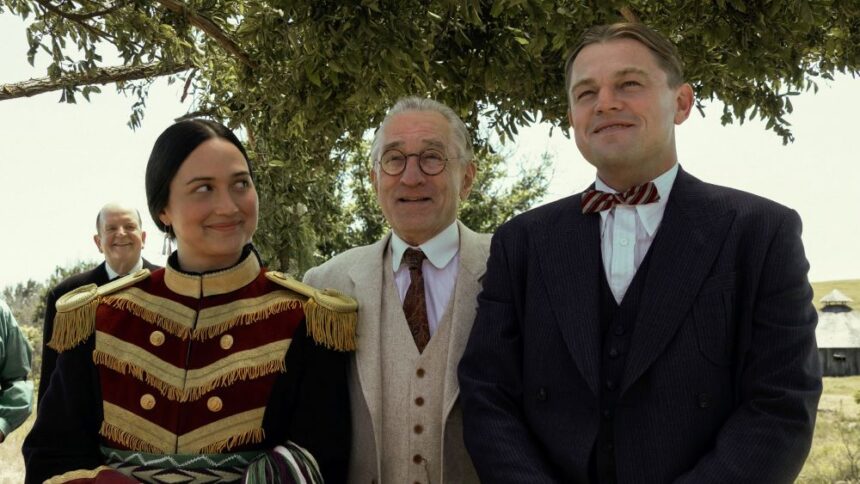(Image: Scene from Killers of the Flower Moon)
“The mindless and hysterical banality of the evil presented in The Exorcist is the most terrifying thing about the film. The Americans should certainly know more about evil than that; if they pretend otherwise, they are lying, and any black man, and not only blacks—many, many others, including white children—can call them on this lie; he who has been treated as the devil recognizes the devil when they meet.” — James Baldwin, The Devil Finds Work
***
James Baldwin was deeply troubled by The Exorcist (1973), a film he insisted on seeing twice despite how much he despised it. His reflections on the film make up the last few pages of his 1975 book, The Devil Finds Work. He was “most concerned with the audience,” and “wondered what they were seeing, and what it meant to them.” Baldwin watching the audience watch The Exorcist led him to declare that the most terrifying thing about it was “the mindless and hysterical banality of the evil presented” therein.
Two recent films—Martin Scorsese’s Killers of the Flower Moon (2023), about the Osage murders of the 1920s, and Jonathan Glazer’s The Zone of Interest (2023), about a Nazi family’s life right outside Auschwitz—brought Baldwin’s striking turn of phrase back to my mind. At first glance it might sound more than a bit idiosyncratic to speak of two critically-acclaimed historical dramas in the same sentence as “the scariest movie of all time.” And yet, each is a meditation on evil; each was nominated for Best Picture at the Academy Awards; and, surprising as it may seem, each has an element of Catholic horror to it as well.
As I’ve written elsewhere for The Revealer, “Catholic horror” is a subgenre that invokes demonic forces in order to reinforce the power of the divine and, by extension, the supernatural authority of the Catholic Church. It runs on nostalgia for an imagined past when people recognized the real presence of God (and the Devil) in their midst and lived accordingly. (This is why so much Catholic horror is framed as “based on a true story.”)
What is missing from most Catholic horror—what Baldwin critiqued as “mindless and hysterical banality”—is any real assessment of the frightening human capacity for evil. Killers of the Flower Moon and The Zone of Interest accomplish this to devastating effect. And, it turns out, the central figures of both films happened to be Catholic. For this reason, I argue we should consider both to be Catholic horrors movies. If Catholic horror (singular) invokes supernatural evil to reinforce the authority of the Church, a Catholic horrors film (plural) reveals the human evil unleashed by Catholics and their Church in history.
But before we get ahead of ourselves, let’s begin with a word on the ostensible subject of all three films: “evil.” The word has an absolutism about it. No ifs, ands, or buts, it seems to say. Things may be wrong, people may be bad (or very very wrong and very very bad), but evil is something else entirely. To call something “evil” is to comment on an exceptional quality, to place it beyond the pale and far past the point of redemption.
We shouldn’t be surprised, then, that Evil (with a capital-E) is alive and well in horror. Horror fans can’t wait to watch irredeemably insidious, sinister, malignant, and barbaric figures wreak havoc on the world. In the nightmare realms of serial killing psychopaths and the supernaturally possessed, the Devil really does prowl about the world seeking the ruin of souls. Weirdly, this is what makes such movies fun and reassuring. They operate with a kind of Manichean moral clarity. Evil is real. The point is to send it back to Hell, or, more modestly, to survive it.
All of which can feel too trite to be “high art.” Evil is the pulpy stuff of B-movies, par excellence. High-brow cinema (the literature of the multiplex) traffics, instead, in complexity and moral ambiguity. Killers of the Flower Moon and The Zone of Interest buck this trend, though.
In Killers of the Flower Moon, Scorsese adapted David Grann’s book of the same name and produced a harrowing portrayal of the Osage Reign of Terror in 1920s Oklahoma; the period in which white settlers conspired to murder over sixty Native Americans of the Osage nation in a plot to inherit their oil wealth. In The Zone of Interest, Glazer loosely adapted Martin Amis’s work of historical fiction to make a movie that follows a Nazi commandant’s family as they live a disturbingly ordinary existence just outside the walls of the Auschwitz concentration camp.
These unrelenting reflections on evil were two of the most critically acclaimed films of the past year. Killers was nominated for ten Academy Awards. Zone took home Oscars for Best International Feature Film and Best Sound. Neither invited sympathy nor explored complex motivations. They both projected evil onto the silver screen and insisted you watch without blinking. Quite like a horror movie. Indeed, the first time I saw Killers of the Flower Moon I thought to myself: “My god, that was a Catholic horror movie.”
Yet, as I alluded to earlier, “Catholic horror” wasn’t quite the right descriptor. The Exorcist is archetypal Catholic horror. Evil in the 1973 film is a personified physical force. It is not a symbol for human suffering or a metaphor for civil strife. As writer Patricia Lockwood recalls her father putting it to her when she was a child: “This story is absolutely true…This was not a psychological disturbance. This was not puberty. Don’t listen to the shrinks. This was the presence of evil, pure and simple.” (Her father happens to be a Roman Catholic priest.) Fifty years of Catholic horror followed in its footsteps and the subgenre continues to insist that evil is the demon possessing your daughter and your only hope is the compelling power of Christ.
Killers of the Flower Moon, in this sense, should not be considered Catholic horror. The evil depicted in the film is undeniably real, not a mere metaphor for Scorsese. However, the evil shown in the movie is distinctly human – unleashed by white Catholic settlers upon the Osage people. This is why it can be described as a Catholic horrors film, a fact that Scorsese, a Catholic filmmaker, would likely not dispute. “Killers of the Flower Moon” is filled with Catholic characters, both among the Osage community and the white settlers plotting against them. The religiousness of the villains in the film, particularly Ernest and his uncle William K. Hale, is often overlooked. Hale, known as the “King of the Osage Hills,” used his Catholicism to cloak his sinister actions within the community. Similarly, “The Zone of Interest” also portrays a dark side of Catholicism through the character of Rudolf Höss, the commandant of Auschwitz, who was raised in a devout Catholic family.
It may be tempting to dismiss these characters as “bad Catholics,” but this overlooks the role of religious institutions in historical atrocities. By exploring the evil depicted in these Catholic horrors films, we are forced to confront the banality of evil, a concept famously articulated by Hannah Arendt. These films shed light on a type of evil that must be acknowledged and reckoned with, challenging us to consider the complicity of religious traditions in the sins of the world. To highlight a few reviews, the movie critic for Baltimore Magazine started by referencing Hannah Arendt’s phrase “The banality of evil” while watching Martin Scorsese’s impactful “Killers of the Flower Moon.” The Tatler mentioned how Scorsese delves into racism, the banality of evil, and greed. Anthony Lane from The New Yorker titled his piece on “The Zone of Interest” as finding banality in evil at Auschwitz. IndieWire also referred to Jonathan Glazer’s film as a chilling exploration of the banality of evil.
The thematic parallels between these two movies have not gone unnoticed, with Alissa Wilkinson articulating how both films tackle mankind’s capacity for extermination while justifying it as the right thing to do. She emphasizes how these atrocities feel relevant in today’s world of rising prejudice, racism, and fascism.
Hannah Arendt’s phrase “the banality of evil” originated from her coverage of Adolph Eichmann’s war crimes trial and was later published as “Eichmann in Jerusalem: A Report on the Banality of Evil” in 1963. Arendt’s intention was not to excuse Eichmann’s actions but to highlight how seemingly ordinary individuals could commit such monstrous acts. She exposed the societal norms that allowed evil to become banal, indicting the culture that produced individuals like Eichmann.
Both “Killers of the Flower Moon” and “The Zone of Interest” serve as reminders of how those in power can orchestrate extermination for personal gain. Scorsese focuses on the ubiquity of evil and community complicity in the Osage murders, while “The Zone of Interest” translates Arendt’s ideas into a horror film narrative. The differences in approach between the two films provide valuable insights into the normalization of evil in society.
In conclusion, the exploration of the banality of evil in these films prompts reflection on how atrocities can become routine and ingrained in everyday life. The critical reviews and analyses of these movies offer profound insights into the darker aspects of human nature and societal structures. Whether or not he would have appreciated Killers or Zone, Baldwin would have at the very least recognized the evil they presented. As he observes elsewhere in his essay:
“For, I have seen the devil, by day and by night, and have seen him in you and in me: in the eyes of the cop and the sheriff and the deputy, the landlord, the housewife, the football player: in the eyes of some junkies, the eyes of some preachers, the eyes of some governors, presidents, wardens, in the eyes of some orphans, and in the eyes of my father, and in the mirror. It is that moment when no other human being is real for you, nor are you real for yourself. This devil has no need of any dogma—though he can use them all—nor does he need any historical justification, history being so largely his invention. He does not levitate beds, or fool around with little girls: we do.”
Evil cannot be easily exorcized. It has, in no small part, made the world in which we live and move and have our being. Killers of the Flower Moon and The Zone of Interest, like Baldwin and Arendt before them, insist that we see evil for what it is. It is only in recognizing it that we can do anything about it.
Matthew J. Cressler is an independent scholar of religion and chief of staff of the Corporation for Public Interest Technology. He is the author of Authentically Black and Truly Catholic: The Rise of Black Catholicism in the Great Migrations and the creator of Bad Catholics, Good Trouble, an educational webcomic series. He is currently co-writing Body & Blood: Catholic Horror in America with Jack Lee Downey, Kathleen Holscher, and Michael Pasquier.
Source link





